
archives for 03/2018
Making a new seed starting
station to get ready for the Spring garden.
Mug hooks make it easy to
raise and lower the chain holding the light.
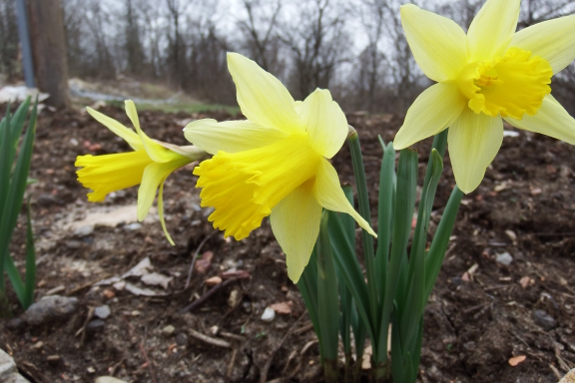
It turns out that
planting the
daffodils Mom so kindly sent me was like bringing coals to
Newcastle. They did bloom a little earlier due
to the two weeks they spent inside, but lots of pre-existing bulbs
poked up their heads along the road soon thereafter.
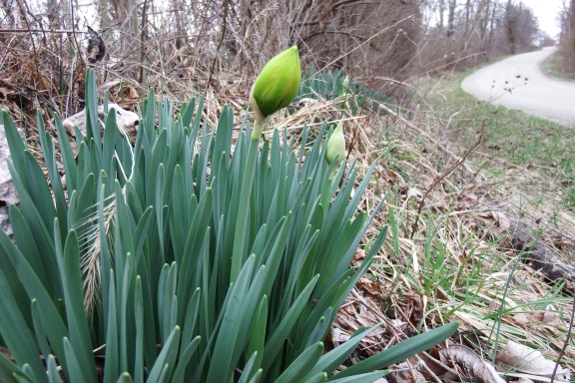
Time to guess the
previous owner's taste in spring flowers! I'm guessing these are the
more ruffly, complex daffodils from the size of the head. But only time
will tell.....
I decided to make the next trailer skirting door with a vertical vent door.
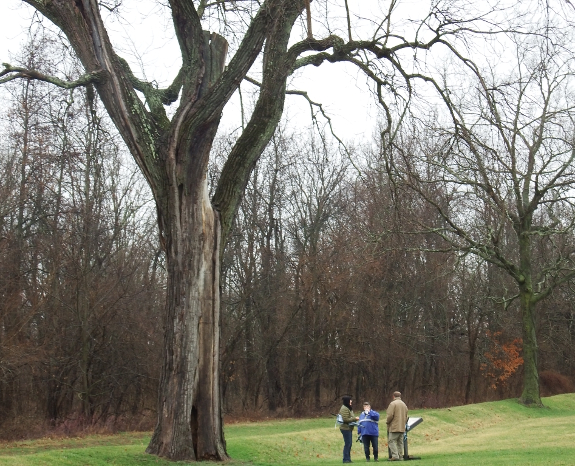
I like to go places that
make me feel small.
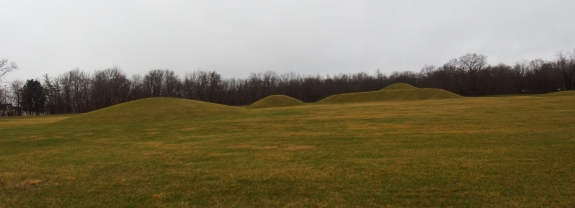
Mark and I had actually
been to Mound City (Hopewell Culture National Historical Park) before,
but somehow I didn't manage to make a post about it. Probably because
we were just passing through, on a road trip deadline. This time, we
made a day of it and spent two edifying hours on the site.
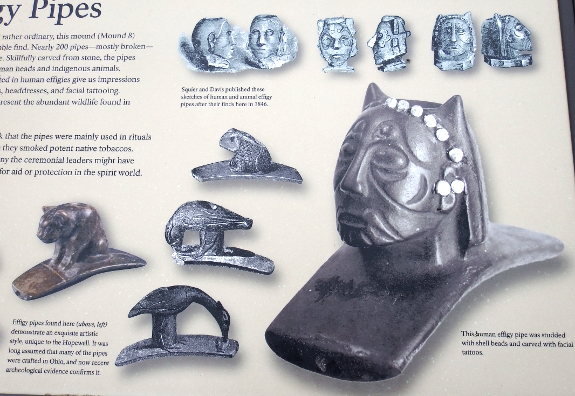
A new and improved
interpretative movie helped me understand the site much better than I
had the last time around. Apparently, during the Hopewell period (200
BC to 500 AD), there were no cities in the region. People lived as
family units, with three dwellings the most that have ever been found
in one place.
There was no big
political structure either, and everyone hunted or gardened for their
own food. And yet, despite all this, the Hopewell people were able to
create artworks rivalling those produced by societies with a designated
artisan class.
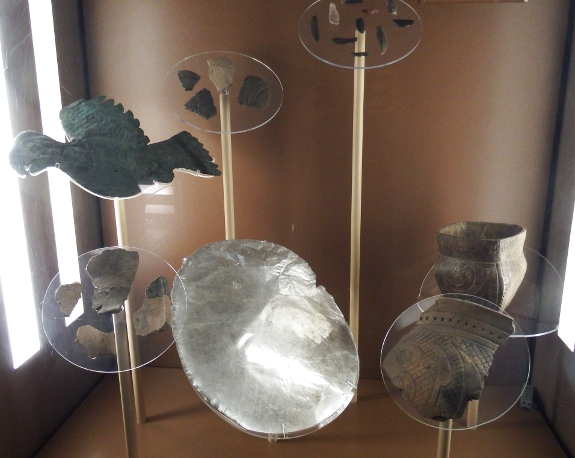
They also brought in
goods from very far afield, perhaps via ceremonial journeys rather than
through trade. The mica from North Carolina particularly inspired me
because I could see how the reflective surface might tie into the
various Hopewell sites' Stonehenge-like obsession with astronomy and
the sky.
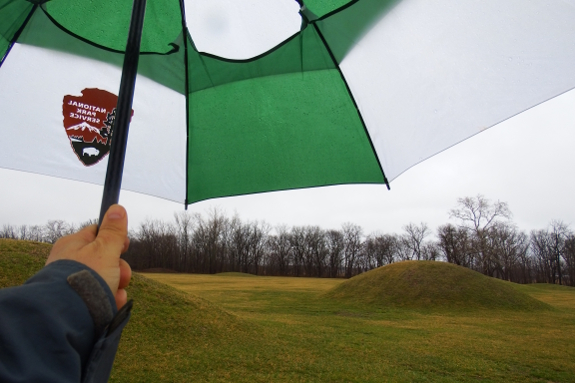
"These walled complexes
were likely the gathering places of people who wanted to form community
even though they were not living together in villages," one brochure
read. Sounds a lot like a homesteading blog, doesn't it? Perhaps that's
why these massive earthworks fire my imagination and send me plotting
out more visits to other sites in the near future.
Helping some local graduate
film students this week gave me a chance to see a DanaDolly up close and learn how
easy it is to set up and use.
16 wheels makes for a very
smooth dolly motion.
The camera is a Canon C100
cinema camera.
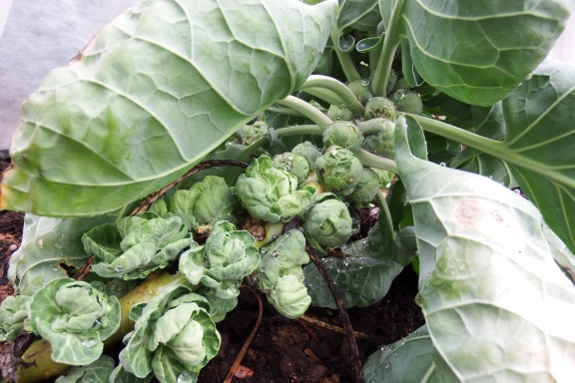
When's the best time to
pick overwintering brussels sprouts? About two
weeks ago, based on the fact that the older sprouts are opening up on
me.
I hurried to pick everything --- a pretty good haul, although not as
sweet as they would have been in cooler weather.
How far did we have to drive
to find compost that can be loaded into our truck?
A short 15 minute drive.
The price was 45 dollars per
cubic yard.
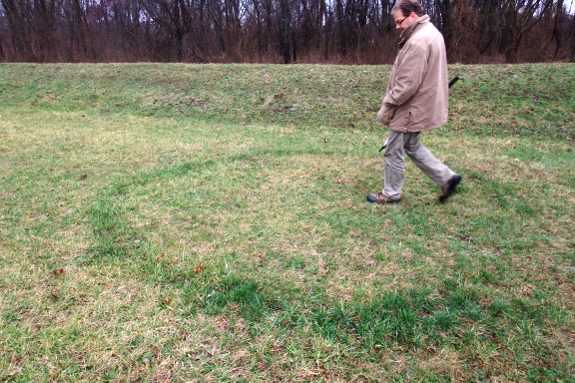
I'd never seen a fairy
ring until last summer, when one popped up in a neighbor's yard back in
Virginia. I'm still kicking myself for failing to take a photo! But I
did get a shot of the winter symptom of the same fungi, shown above
during our recent visit to Mound City.
In a great example of
the symbiosis of plants and mushrooms, fairy-ring fungi break down
organic matter in the soil, releasing nutrients and creating rings of
bright green grass that look like someone had poured fertilizer there.
Unfortunately, they can sometimes also create rings of dead brown grass
if the fungi block water movement or create hydrogen cyanide.
As with much of nature,
it's a crapshot whether the 50 species of fungi that form fairy rings
will help or hinder your lawn. But they definitely increased our
enjoyment of the Mound City site!
We took out our spile today
due to the warm weather.
I think when we tap next year
we'll do it sooner.
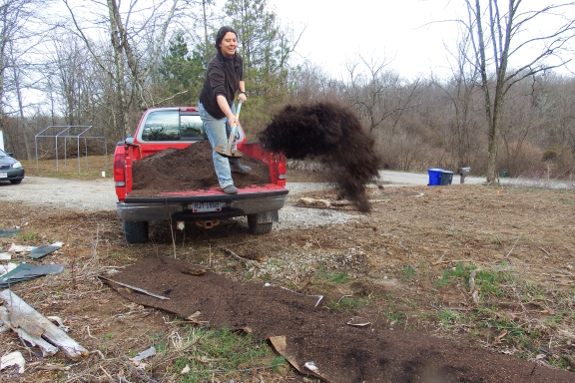
Starting a new garden is
always an exciting undertaking. This time around, I'm learning from
past mistakes. So the rows are all straight and perpendicular to the
(not-yet-erected) fenceline. Perennial bed widths are planned based on
their eventual occupants --- narrower for asparagus and wider for
brambles. And aisles are a universal 29 inches wide.
I'm going with the
ultra-simple kill mulch in most areas --- compost over cardboard ---
although I know I'll have to deal with some perennial weed intrusions
over the course of the first year. Blueberry-bed preparation is more
complicated, though. Stay tuned for details in a later post!
Anna teaching a group of three neighbor kids how we dry shitake mushrooms.
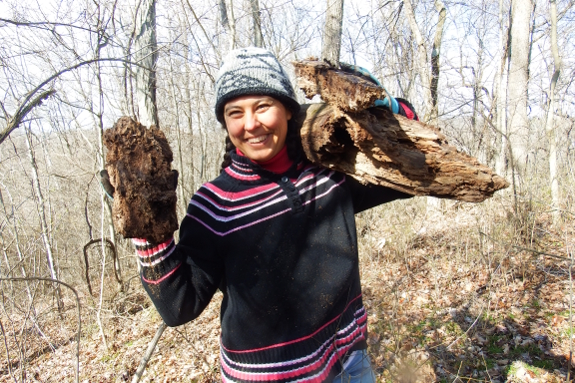
I really meant to prep
our blueberry bed the instant we landed on our new property. After all,
soil acification takes several months, especially in cold winter soil.
But getting our water turned on, installing a source of heat, then
keeping the pipes from freezing seemed slightly more important...so
here it is a week before the bushes arrive and I have no soil ready to
put them in.
Which is a long way of
saying, before I dive into the rest of this post, please do as I say
not as I do. Prepare your blueberry beds months in advance!
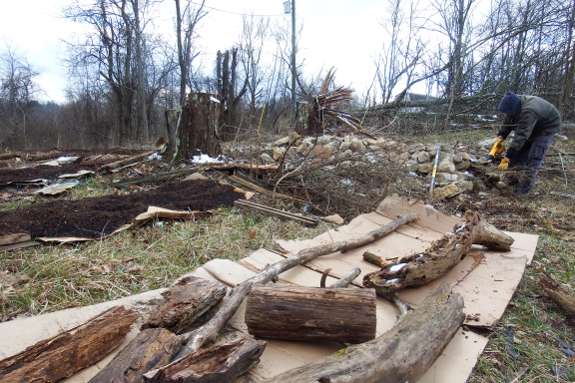
Okay, caveat aside, back
to the point at hand....
Blueberries like three
things --- lots of organic matter, lots of water, and lots of acidity.
The first two points can be assisted by starting your bed off with a
healthy helping of punky wood (placed atop a kill layer of cardboard in
this image so we don't need to till). In a perfect world, this wood is
already starting to crumble apart, although any logs and limbs dead
enough to fall to the forest floor will do in a pinch.
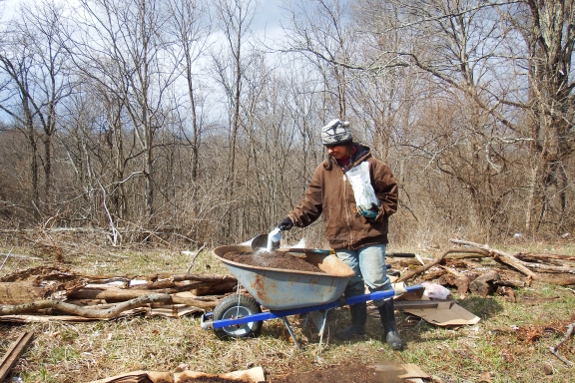
Since rotting wood will
rob some nitrogen out of the soil for the first couple of years, I'm
going very heavy on the nutrients in our blueberry bed. In fact, we're
filling in all the gaps between the wood with straight compost...well,
straight compost laced with sulfur.
"Sulfur?" you say. "That
doesn't sound very natural." Unfortunately, I learned the hard way with
our last blueberry patch that natural
methods of acidifying the soil aren't quite enough for these
acid-loving plants.
So I bought five pounds of ferrous
sulfate (faster acting than elemental sulfur) and did some
back-of-the-envelope math to figure out how much to apply.
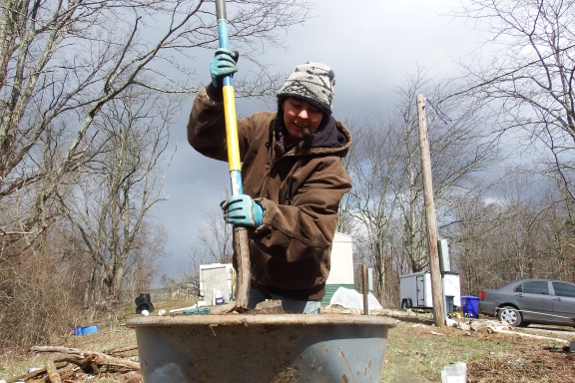
Without a pH test and
with blueberries hitting the ground in short order, I'm playing it safe
and assuming I'll need to top up the sulfur every year for a couple of
seasons. To that end, I used one heaping cup per wheelbarrow load of
compost (which is much easier to mix if you sprinkle half a cup on top
of half a wheelbarrow of compost then repeat with the second half on
top of the full load). This assumes the compost has a pH around 6.5,
the underlying soil is clay loam, and that you're using ferrous sulfate
--- for elemental sulfur, lower the application rate down to two
tablespoons per wheelbarrowful of compost.
I guess we'll know by
the end of the summer whether the blueberries approve of their new
home. We only bought three test plants to get us started, but if they
do well I suspect we'll expand.
We finally got around to installing our Heavy-duty rain gauge on the back porch.
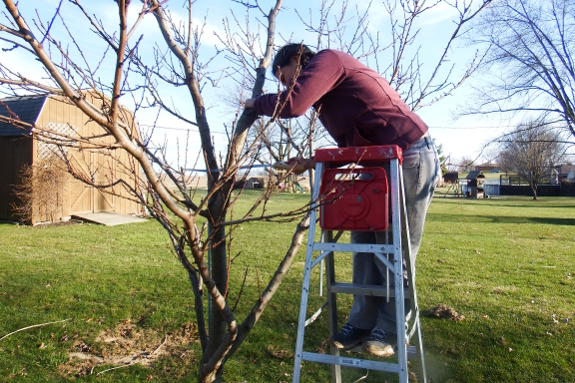
I'm forcing myself not
to plant any trees until this coming winter, once I better understand
the lay of our new land. But I started going into fruit-tree withdrawal
in early March --- good thing Jayne had a pair of peaches she was
willing to let me prune!
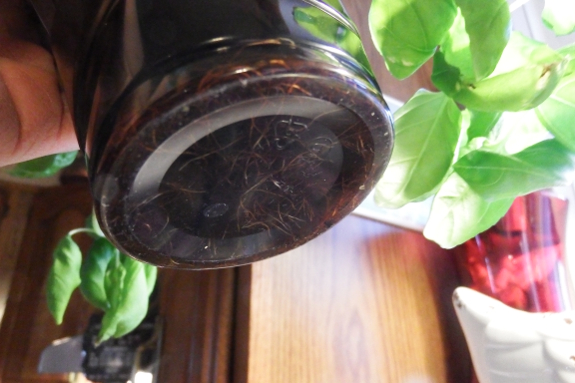
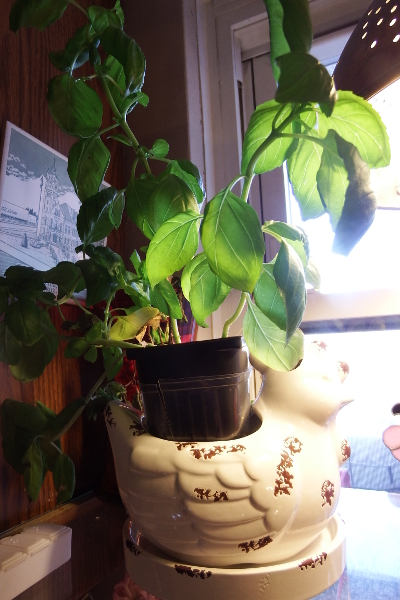 Every
time I go over to Mark's mom's house, I'm impressed by the thriving
basil in her kitchen window. In my experience, basil isn't thrilled by
winter conditions even indoors. So I asked for tips on keeping this
tender herb alive in March.
Every
time I go over to Mark's mom's house, I'm impressed by the thriving
basil in her kitchen window. In my experience, basil isn't thrilled by
winter conditions even indoors. So I asked for tips on keeping this
tender herb alive in March.
"The trick," Rose Nell
told me, "is lots of water." She places the basil's pot inside a cup,
which she keeps at least halfway full of water. Roots expand out from
the pot into the water, in essence turning the growing space into a bit
of a hydroponics setup.
And it works! The proof
is in the pudding...or rather, in the roasted potatoes and salads
seasoned with fresh herbs in January, and February, and March. Maybe
next winter I'll give it a try, but for now I'm content inviting myself
over to enjoy someone else's hard work.
Our first
truck load of compost had a problem with some of the particles
blowing away on the ride home.
A tarp tied down with bungee
cords helped us get the second truck load home without leaving a trail
of compost particles.
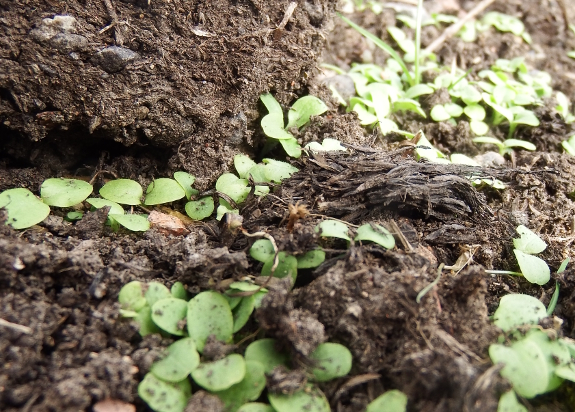
Our spring frost-free
date is supposed to be five days later here than it was in Virginia, so
I tweaked my garden spreadsheet to match. Of course, spring planting
times are more of an art than a science. It's all about current soil
temperature and upcoming rainfall and two-week forecasts...and my mood
that day.
To cut a long story
short, I direct-seeded my first lettuce seeds two weeks earlier than I
did last year in Virginia. They're growing slowly but surely, despite
the fact I didn't even slap a quick hoop over them until lows dropped
back into the mid twenties sometime last week.
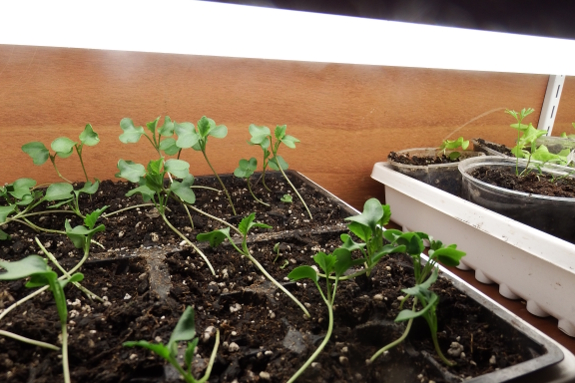
Meanwhile, my inside
seedlings are doing pretty well, considering the fact I let them sit on
the floor without lights for way too long. Stems are a bit leggy as a
result, and the cat trampling didn't help either. Now that Mark's given
them their own shelf and lights, though, I think we're back on track.
No, Huckleberry, my grow zone is not your play pen.
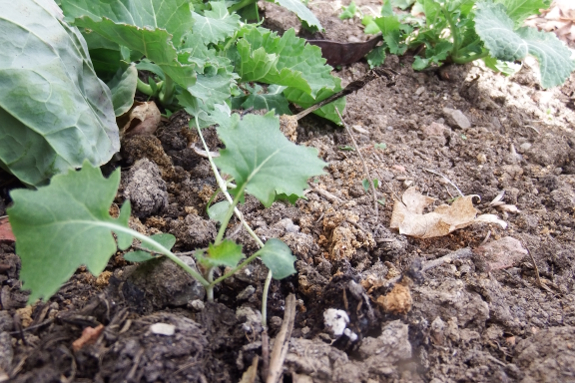
I went ahead and
transplanted some baby kale outside to join the few overwintering
specimens I have under quick hoop number two.
The older plants are
starting to put out enough leaves to provide a small meal occassionally
--- so good to have real, flavorful food on our plates again!
Anna inspecting the cardboard
we picked up on Sunday.
Thank you Kiara for the gift
of cardboard (and Mom and Jayne for the recently used stash).
The former might last a week
at this point in garden planning. The latter is already long gone.
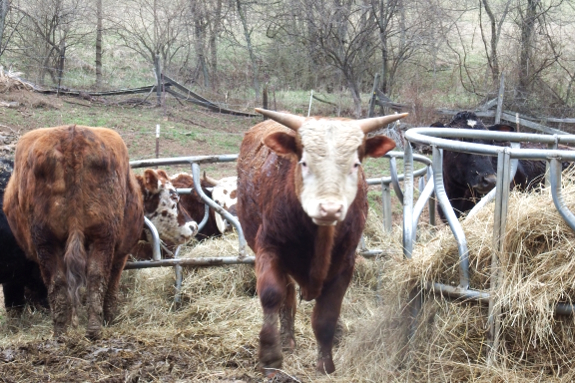
Even just a couple of
miles down the road in a less exposed location, mud season is still
very real. But up here on our ridge, the soil is bone dry. Clearly,
we're going to have to get our irrigation setup working sooner rather
than later.
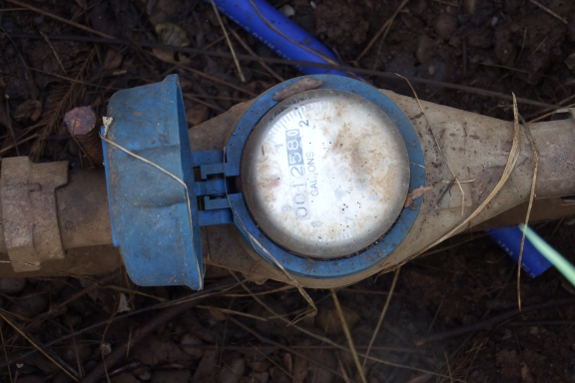
To Mark's joy (no
jury-rigging solutions out of baling twine and shoestrings!) and my
disgust (chlorine, fluoride, energy-intensive, money-squeezing, limited
supply!), we're on city water in our new location. I can't recall
exactly how much we're allowed to use each month for the base rate ---
I think 500 or 600 gallons? So far, we're using about half that, but
gardens are thirsty beasts.
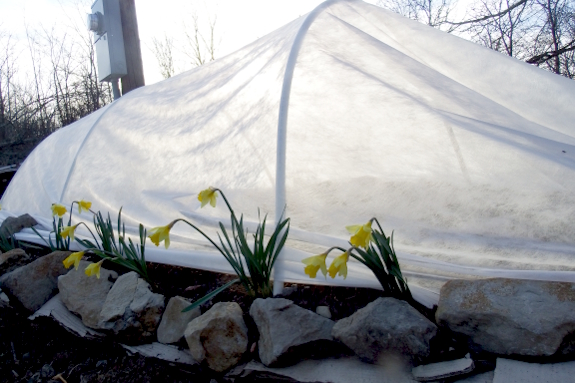
So we're starting to brainstorm the best solution. The first step will be gutters...but where should we channel the precious off-flow? I go back and forth between spending some cash to build as big a pond as we can fit at the edge of our yard, creating an in-ground cistern out of concrete, or just going the plastic storage tank route. I'm all ears if anyone has first-hand results of any of those options!
Our neighbor needed to thin
out her flock and we agreed to help.
My first time using a One Tie
to secure a rooster's feet together might be a new trend for me.
It's easier than a piece of
rope and seems to have zero chance of it coming loose.
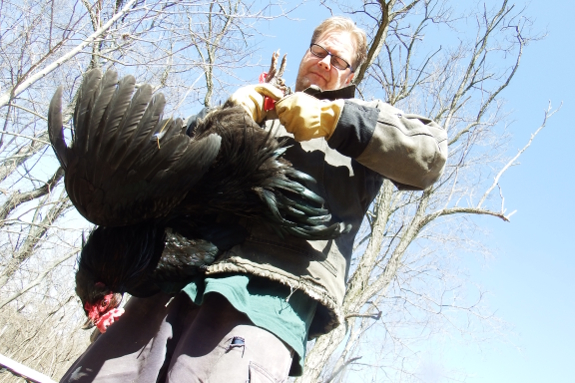
After five and a half
months living like normal Americans, Mark and I are itching for real
food. Yes, the stuff at the farmer's market is better than the stuff at
the grocery store. No, neither holds a candle to the produce and meat
we're used to harvesting from our own farm.
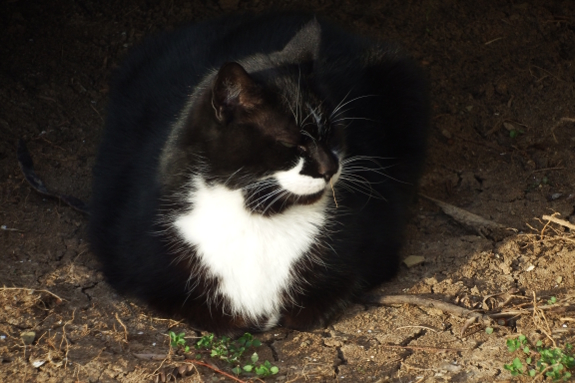
A hankering for real
chicken broth is what tempted us to take two of the dozen roosters our
neighbor is trying to get rid of. We cut up and ground the meat then
cooked the rest of the carcass down into broth...at which point our
cats went nuts. These spoiled darlings won't get off the couch for
factory-farmed poultry, but they just about drove me crazy sneaking
onto the counter trying to get into that stew pot to gnaw at free-range
chicken bones.
Of course, processing
old roosters isn't easy. We'll see how nourished we feel by the meat
and broth, then will decide whether to accept the other ten birds.
It's possible to retire a rooster without a bucket or cone....but not recommended.
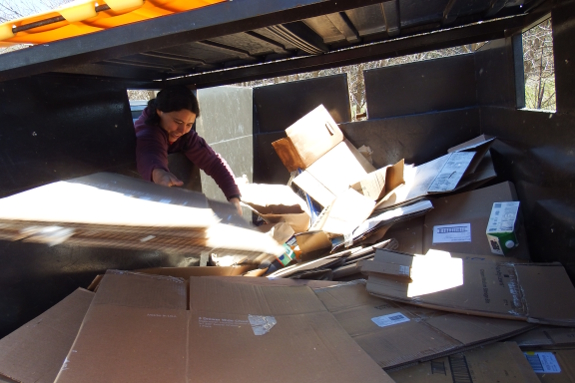
The radio is full of
news about how China no longer wants our paper and plastic, resulting
in low commodity prices and buildups at recycling centers. Despite all
that, a bit of sleuthing suggested our best option for bringing home
bulk cardboard is still dumpster diving.
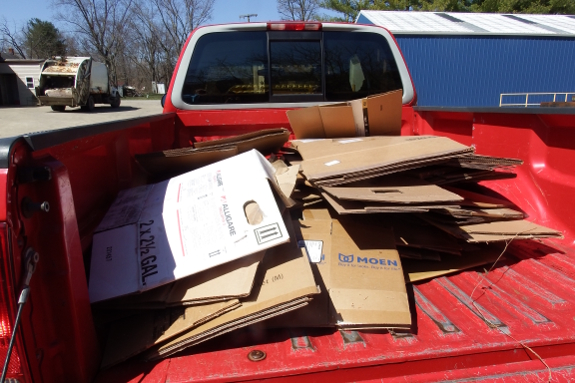
In Dungeons and Dragons
terms, I consider myself Lawful Good. So I was a little leery of
rooting through the dumpsters for two reasons.
First, I had a feeling
dumpster diving was illegal. The internet, on the other hand, suggests
that as long as you're in a public area (thus aren't trespassing) and
don't create a disturbance, you're likely okay on the legal front.
But is taking cardboard
that folks were hoping to recycle ethically sound? This is a trickier
topic since recycling cardboard lowers energy usage and saves trees at
the upstream end of new product creation. On the other hand, we'll be
using our cardboard to grow food, sequestering carbon in the soil and
reducing energy use during production and shipping.
In the end, I figured
dumpster diving cardboard was at least ethically neutral. Which is a
good thing since my hungry garden needs cardboard now!
We celebrated the Spring
Equinox with a day trip to Serpent Mound.
It's been 9 years since our last
visit to this unique transmission from the past.
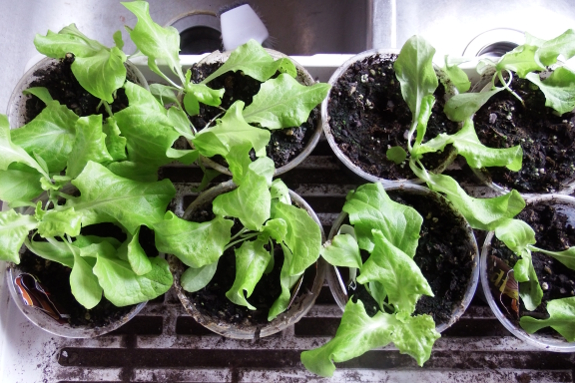
About a month ago, I set
up a side-by-side comparison of two kinds of high-quality
potting soil. The
photo above shows the results.
Top row is Fox Farm and
bottom row is Happy Frog...and I'd have to say both composts worked
pretty much the same. (The big difference between the plants on the
right and the plants on the left is due to the former being further
from the window before we got our lights up and running.)
I also started seedlings
directly in both types of compost and saw no damping off or other
germination problems in either. So I guess we'll be nabbing another bag
of whichever is cheapest the next time we visit White's Mill. In the
meantime, I'm hoping we get a warm spell soon so these big lettuce
plants can go out in the ground.
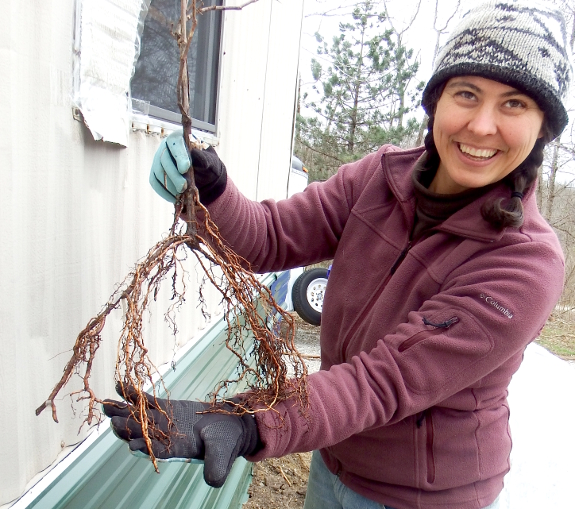
I know I said we weren't
going to buy any trees until next year...but I figured I could slip in
a few bushes and grapes this first spring. The latter came on Saturday,
with hefty roots that continue to put Starks near the top of my
favorite-nurseries list.
These grapes are meant
to replicate our
past success as
closely as possible. So we stuck to the same variety --- Reliance ---
and the same location --- outside the west-facing window. As hefty as
these plants are, Mark may have to build them a similar trellis this
year too.
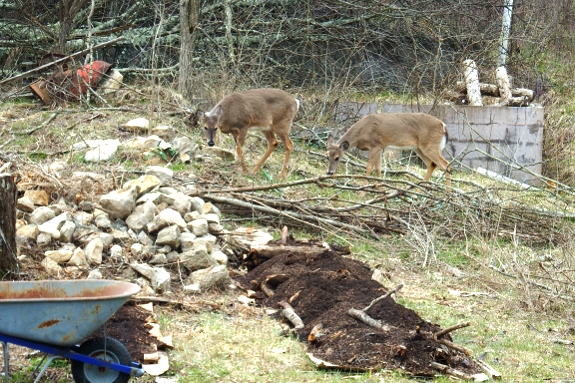
"Future lunches. Pretend you don't notice and maybe they'll forget to build the fence."
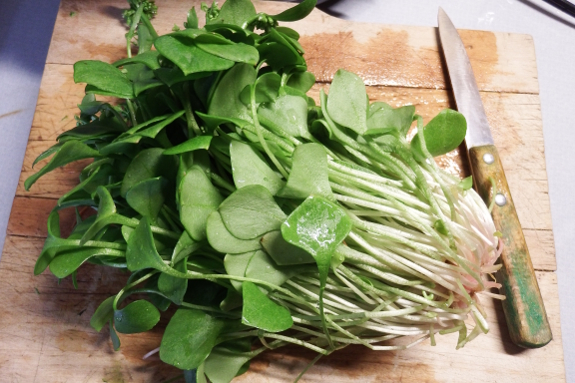
Claytonia
is one of the ultra-cold-resistant crops recommended by Eliot Coleman, but I've never planted it
in my own garden. It's hard to commit space to a plant I've never
tasted before. So I was delighted to find a clump for sale at the
farmer's market. $2.50 to test how the plant works on our palates
seemed like a pretty good deal.
The conclusion? Eh.
Claytonia is probably the blandest green I've tasted. Yes, in late
January when everything else is dead, I might appreciate it. But I'd
rather focus on the sweetness of overwintering kale.
We got 12 bales of straw for 48 dollars. The drive was about 40 minutes each way.
Want more in-depth information? Browse through our books.
Or explore more posts by date or by subject.
About us: Anna Hess and Mark Hamilton spent over a decade living self-sufficiently in the mountains of Virginia before moving north to start over from scratch in the foothills of Ohio. They've experimented with permaculture, no-till gardening, trailersteading, home-based microbusinesses and much more, writing about their adventures in both blogs and books.
